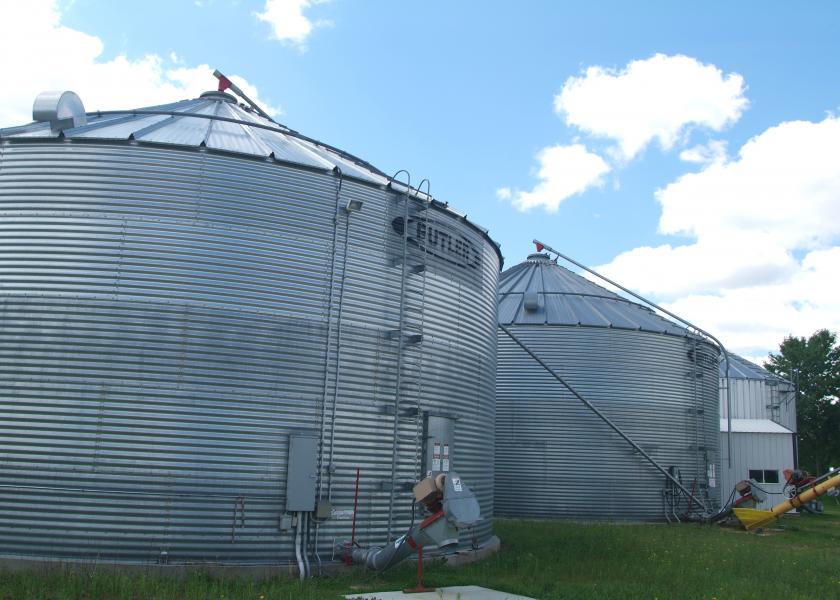Grain Storage: 13 Signs Something Went Wrong

A variable year means the managing the grain in your bin could be equally challenging.
The longer grain is in storage, the more important it is to look for problems. Here are 13 potential issues, causes and solutions according to experts from Purdue University and Iowa State University.
- Musty or spoiled grain odor.
- Cause: Heat or moisture accumulation in one spot.
- Solution: Run the fan to cool hot spots, if damage is too severe remove grain.
- Hard layer below grain surface.
- Cause: High moisture or spoiled and caked grain mass.
- Solution: Run aeration or drying fan. If caked or compacted mass blocks airflow remove, and resume cool and dry airflow.
- Warm grain below surface.
- Cause: High moisture.
- Solution: Run aeration fans regardless of external weather conditions until the exhaust air temperature measures as the desired grain temperature.
- Grain is wet, slimy, sticking or frozen together.
- Cause: Early moisture migration—noticeable in the first two weeks grain is in the bin.
- Solution: Run aeration fans to cool grain until exhaust temperatures equal outside air temperatures or your desired grain temperature.
- Hard, caked crust blocking airflow.
- Cause: Severe moisture migration and condensation in the top layer.
- Solution: Removed spoiled grain and run fans to cool remaining grain. Take samples to find conditions of grain under the crust. If spoilage is a big concern after removing crust, consider selling grain to stop further spoiling.
- Roof condensation dripping onto grain surface.
- Cause: Warm grain in cold weather, severe convection circulation and moisture migration.
- Solution: Aerate until exhaust temperature equals the outdoor air temperature at the beginning of the cycle.
- Wet/spoiled spots outside of center of grain.
- Cause: Condensation drips from bolt ends or under roof fixture that funnels condensation flow or roof leak.
- Solution: Check for hot spots, check roof under surface at night and check for caulking around roof inlets and joints.
- Wet/spoiled spot under fill cap.
- Cause: Leaking roof cap or condensed water from gravity spout.
- Solution: Check bin cap seal, block or disconnect gravity spout so air cannot flow up tube. Short term: Hang bucket under spout inlet and check for water.
- No air flow with while fans are running.
- Cause: Caked or moldy grain mass blocking air or moldy grain layer above aeration duct or perforated floor on suction system.
- Solution: Find spoiled grain to determine location and scope, unload bin and market good grain.
- White dust when stirred.
- Cause: Mold on top layer.
- Solution: Evaluate grain, determine extent of damage and decide if grain will continue to deteriorate. If so, consider no longer storing damaged grain.
- Cooling takes longer than normal.
- Cause: Fines in grain reducing airflow or two to four times airflow resistance when compared to clean grain.
- Solution: Run the fans longer, until grain and exhaust temperatures show desired temperature.
- Exhaust air temperature in center of bin surface warmer than off-center.
- Cause: Fines accumulate in the center and resist airflow, making the airflow in the center less than surrounding areas, therefore hotter.
- Solution: Run the fan long enough to cool the center exhaust, draw down bin center to remove find and decrease depth for easier air flow in core.
- Unknown grain condition in bin center.
- Cause: Too deep to probe, bin is too full to access or no temperature cables are installed.
- Solution: Withdraw some grain, observe first grain to flow from each withdrawal, as it is in the center. Withdraw any storage filled above full level to reduce moisture migration and allow access to center for sampling.
Check grain weekly during fall and spring and at least every two weeks in the winter to avoid compounding problems. Exhaust fan odors can clue you into problems within the bin, too.
Active management and observation can help you avoid major catastrophe in stored grain.







